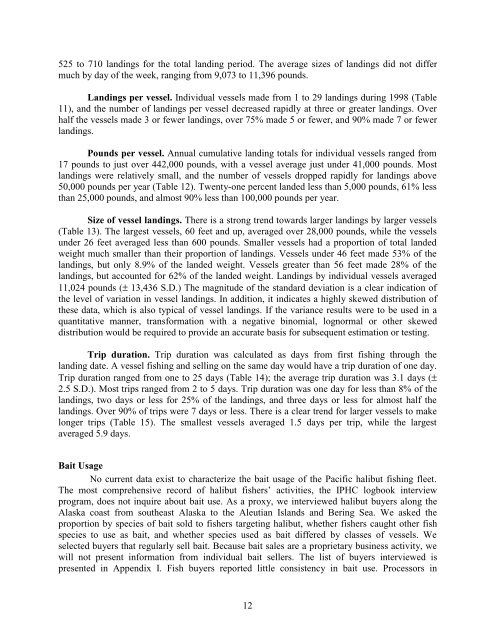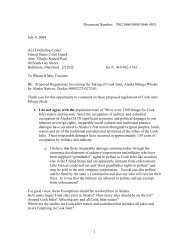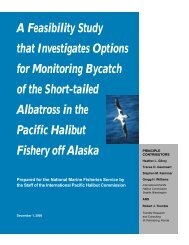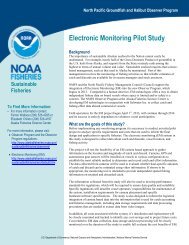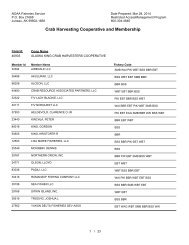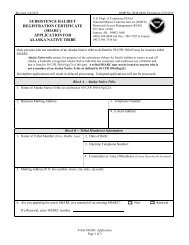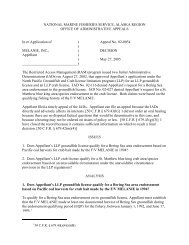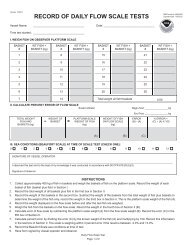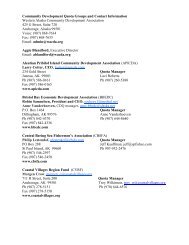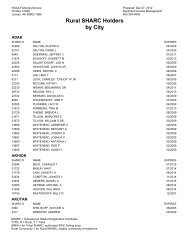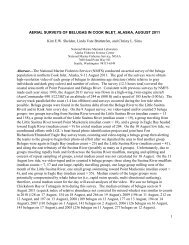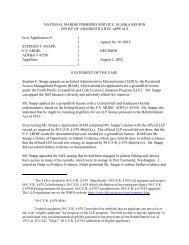Revised Report - National Marine Fisheries Service Alaska Region ...
Revised Report - National Marine Fisheries Service Alaska Region ...
Revised Report - National Marine Fisheries Service Alaska Region ...
Create successful ePaper yourself
Turn your PDF publications into a flip-book with our unique Google optimized e-Paper software.
525 to 710 landings for the total landing period. The average sizes of landings did not differmuch by day of the week, ranging from 9,073 to 11,396 pounds.Landings per vessel. Individual vessels made from 1 to 29 landings during 1998 (Table11), and the number of landings per vessel decreased rapidly at three or greater landings. Overhalf the vessels made 3 or fewer landings, over 75% made 5 or fewer, and 90% made 7 or fewerlandings.Pounds per vessel. Annual cumulative landing totals for individual vessels ranged from17 pounds to just over 442,000 pounds, with a vessel average just under 41,000 pounds. Mostlandings were relatively small, and the number of vessels dropped rapidly for landings above50,000 pounds per year (Table 12). Twenty-one percent landed less than 5,000 pounds, 61% lessthan 25,000 pounds, and almost 90% less than 100,000 pounds per year.Size of vessel landings. There is a strong trend towards larger landings by larger vessels(Table 13). The largest vessels, 60 feet and up, averaged over 28,000 pounds, while the vesselsunder 26 feet averaged less than 600 pounds. Smaller vessels had a proportion of total landedweight much smaller than their proportion of landings. Vessels under 46 feet made 53% of thelandings, but only 8.9% of the landed weight. Vessels greater than 56 feet made 28% of thelandings, but accounted for 62% of the landed weight. Landings by individual vessels averaged11,024 pounds (± 13,436 S.D.) The magnitude of the standard deviation is a clear indication ofthe level of variation in vessel landings. In addition, it indicates a highly skewed distribution ofthese data, which is also typical of vessel landings. If the variance results were to be used in aquantitative manner, transformation with a negative binomial, lognormal or other skeweddistribution would be required to provide an accurate basis for subsequent estimation or testing.Trip duration. Trip duration was calculated as days from first fishing through thelanding date. A vessel fishing and selling on the same day would have a trip duration of one day.Trip duration ranged from one to 25 days (Table 14); the average trip duration was 3.1 days (±2.5 S.D.). Most trips ranged from 2 to 5 days. Trip duration was one day for less than 8% of thelandings, two days or less for 25% of the landings, and three days or less for almost half thelandings. Over 90% of trips were 7 days or less. There is a clear trend for larger vessels to makelonger trips (Table 15). The smallest vessels averaged 1.5 days per trip, while the largestaveraged 5.9 days.Bait UsageNo current data exist to characterize the bait usage of the Pacific halibut fishing fleet.The most comprehensive record of halibut fishers’ activities, the IPHC logbook interviewprogram, does not inquire about bait use. As a proxy, we interviewed halibut buyers along the<strong>Alaska</strong> coast from southeast <strong>Alaska</strong> to the Aleutian Islands and Bering Sea. We asked theproportion by species of bait sold to fishers targeting halibut, whether fishers caught other fishspecies to use as bait, and whether species used as bait differed by classes of vessels. Weselected buyers that regularly sell bait. Because bait sales are a proprietary business activity, wewill not present information from individual bait sellers. The list of buyers interviewed ispresented in Appendix I. Fish buyers reported little consistency in bait use. Processors in12


